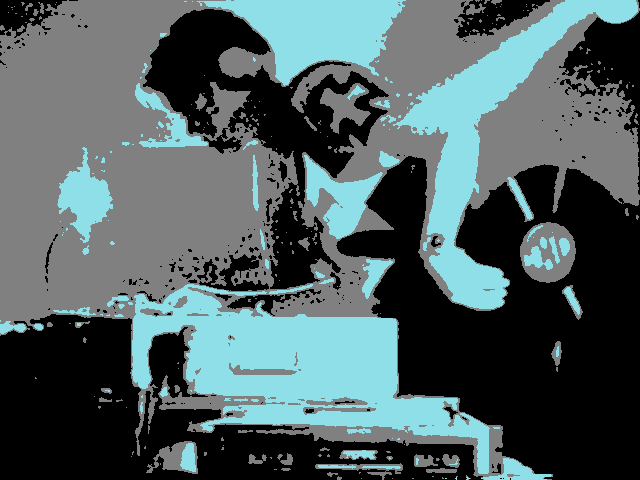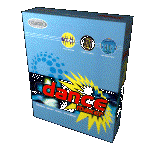


|
Music has been present since the beginning of time. It is a way to communicate, to express feelings, show emotions, etc.. and can be a universal way to express ones self. There are so many types of music such as classical, jazz, alternative, rap, trance, techno, house, etc., that people in our society today listen to. But the one music that has become part of our new media history dealing with electronics and high tech computers is Trance music. Trance is a type of ambience music that uses musical instruments and has no lyrics. We are able to create music with high tech computers which enalbes us to use every type of instrument and mix them together to create incredible music. It is only current that people have been able to accept this type of music. But trance is not just a type of music because the word seems like a type of music. But trance deals with more of the innermind. I do believe this deals with our creativy which effects our society in new media art. This section will deal with the history of trance music and explain other types of trance muisc and where this music is greatly appreciated. |
"What could be more beautiful and perfect than a society based upon the appreciation of music? Music is something that brings people together, can evoke strong feelings in the listener, and transcends language and local culture. Music is as basic as our emotions and is not something that has to be learned in order to enjoy orunderstand. With music, nobarriers exist to keep us apart and break our universal VIBE. "
Since the word trance is closely associated with the musical genre. There is a connection between trance theory and the musical genre 'trance music' or 'techno trance' as well as the trance inducing music of shamans of Africa. Moreover, ritual music of many western and eastern cultures has trance inducing aspects which can be analyzed and described using trance theory. The general trance inducing aspect of music is well-known, but trance theory helps to specifically identify those aspects of music which induce trance, and lays the foundation for describing the nature of the specific trance.Why should we want to do this? One reason is so that we can engineer better trances through music. There is a part of any music that does induce trance. Sometimes itis only the trance inducing aspect of music which many people feel is what makes music successful or not.People get pleasure when they are in a trance. Therefore, if you can make better trances through music, then people will like your music. So, itcomes down to trance engineering. But to do that, you have to have a practical model for trance. You got that. Now all you need to do is apply the model.
The music of shamans and many aboriginal
tribes create effective music which modulates the dissociated
trance plane by slightly varying the underlying trance generating
loop. There are many nature sounds, such as birds, frogs, crickets
which fundamentally repeat, but which contain slight variations
within each repetition.
Music consists of repeating rhythms and melodies. From a trance
theory point of view, music consists of multiple trances, one
for each repeating rhythm or melody.
Most of these musical loops repeat only a few times and there
is a minimum number of repetitions needed before a dissociated
trance plane will be created. Musical
trance can be described as the creation of multiple trances followed
by their collapse. However, another cognitive loop is precisely
this repeated creation and
collapsing of dissociated trance planes.
Certain types of music are more trance-inducing,
generally, than others. Musical loops which are sustained, such
as in shamanistic or so-called trance-drumming,have at least the
critical element of high repetition. Thus, the high repetition
of the musical loop is more likely to produce a single dissociated
trance plane. Religiousand military marching music also has a
higher likelihood of inducing trance because of the high repetition
of the musical loop.
The title of this article is not misleading, but if one only wants
to get high from trance one is certainly using only a small fraction
of the potential magic of the mind. Bu the idea of using trance
as an escape from painful reality rather than a powerful tool
for inner exploration does reflect the most popular utilization
of this interesting and magical cognitive phenomenon called trance.
Many people like to get high with trance.
They are tired of drugs and alcohol and the dangers those bring.
But trance is interesting only if you can control it yourself.
Anyway, just getting high with trance is useful mostly as an escape.
Used with careful precision trance can also be used as a powerful
tool for exploring different and exotic states of consciousness
including what Jung termed the shadow self. If
you hang out in the woods, far away from your friends and meditate,
it is possible to get pretty high. Depending on what kind of thoughts
and feelings are in your brain, cooking your brain for long periods
of time on the flame of meditation can produce either wonderfully
high states or some real awful crazy. The nice thing about
meditation is that it is not hypnotic. But it is a trance. The
difficult part is staying away from friends and other well-meaning
folks who disturb the tranquility. When you stop meditating be
certain to end the trance.
What is acid?
Acid started in about 1988, I don't know
who first used the term 'acid' to describe the music but it probably
refers either to the drug scence which existed around the music
scene or to the biting hard-edged sounds (I'm not talking gabba
hard sounds!). It first spawned from house music as a (slightly)
faster, 'happier' variant (hence smileys ). Since about 1989 when
it was known as 'acid house' it has changed dramatically. In 1990
after being forced 'underground' with the increased police interest
in illegal raves and the banning by the BBC to allow any song
with 'acid' in the title or music it seemed to disappear. In about
1991 it started to re-emerge, in the form of 'hard-acid' which
was a style which had dropped the happy housey pianos and had
taken more of an influence from earlier electro styles. This,
style seemed ill fated though as even greater police inforcement
worked against it. In 1991-1993 this form of music then spawned
into techno with the arrival of a thriving Belgian and Rotterdam
techno scene. Acid at this point in history seemed to disappear
into the background, unitl recently in the mid 90's, where it
has started to apear again with all the other types of trance
music.
 |
MAGIX Entertainment is the multimedia music software company for recording, editing, sequencer, arranging, video and sound. The currently demo so that you can create trance and more ambience. |
A Psychedelic Trance Band releasing tracks under "3D Vision". They are also involve in Tripiatrik, a new wild psy trance sound.
YUMADE is a psychedelic techno band from France. YUMADE is composed by Laurent B. and PéA Click below to here on of their tracks.
Synthaxer